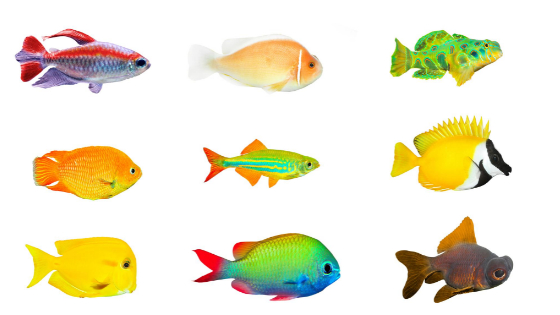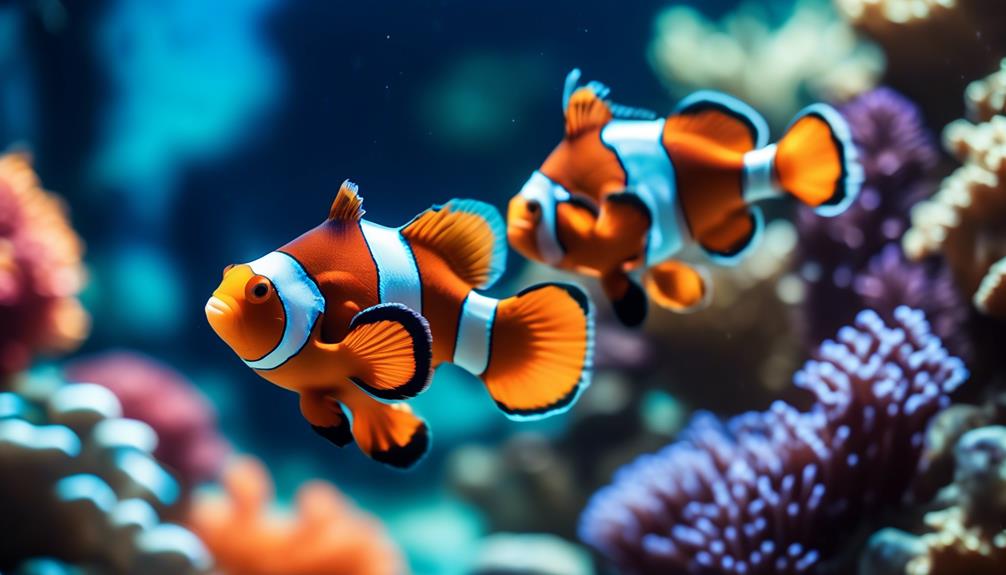
Are you ready to dive into the captivating world of saltwater aquariums, where vibrant and mesmerizing creatures await? Look no further than the beloved stars of these aquatic havens – clownfish! These small-sized fish, with their beautiful colorations and waddle-like swimming motions, are like the graceful dancers of the sea.
But their charm doesn’t end there. As you delve deeper into their world, you’ll discover their fascinating ability to form symbiotic relationships with sea anemones, granting them immunity to the anemones’ poisonous tentacles. Curious to know more?
Join us as we explore the captivating characteristics, suitable tank mates, maintenance and care, as well as feeding and breeding habits of these beloved stars. Get ready to embark on a journey that will leave you captivated and craving for more.
Key Takeaways
- Clownfish are small saltwater fish known for their aggressive temperament and beautiful colorations, making them a popular choice among saltwater aquarium enthusiasts.
- They thrive in 30-gallon aquariums and prefer swimming in the middle region of the tank, so it’s important to provide suitable tank size and create open swimming spaces and hiding places.
- Clownfish develop symbiotic relationships with sea anemones and are immune to their poisonous tentacles. They also have a unique breeding behavior where the dominant male turns into a female and guards the eggs zealously.
- Their community aggressive temperament adds excitement and balance to the tank, showcasing the intricate social lives and hierarchical structure of clownfish.
Clownfish Characteristics
Clownfish are small saltwater fish known for their community aggressive temperament and are typically kept in medium-sized aquariums. These vibrant and lively fish add a splash of color to any marine tank.
They thrive in a 30-gallon aquarium and prefer swimming in the middle region of the tank. Clownfish are suitable tank mates for damsels, dartfish, gobies, hawkfish, puffers, and tangs. They’re the most popular species among saltwater aquarium enthusiasts, accounting for over 40% of total sales in the marine aquarium fish trade.
With their beautiful colorations and waddle-like swimming motions, they’re a joy to watch. Clownfish develop symbiotic relationships with sea anemones and are immune to their poisonous tentacles. They’re relatively hardy, can live up to 6 years in captivity, and adapt quickly to aquarium life.
Suitable Tank Mates
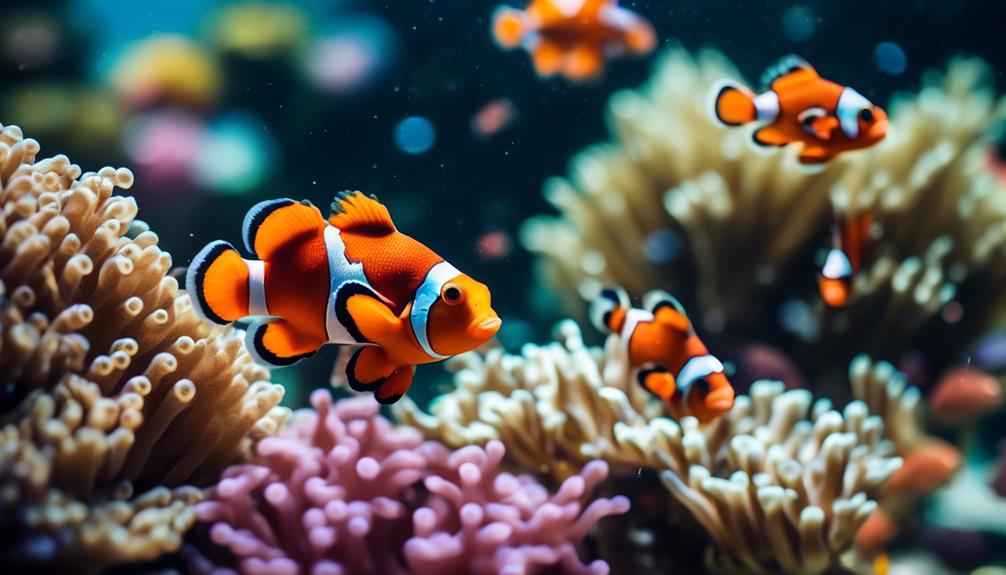
Which fish species are suitable tank mates for clownfish in saltwater aquariums? When choosing tank mates for your clownfish, it is important to consider their size, temperament, and compatibility with clownfish. Here is a table showcasing some suitable tank mates for clownfish:
| Fish Species | Size | Temperament |
|---|---|---|
| Damsels | Small-Medium | Aggressive |
| Dartfish | Small | Peaceful |
| Gobies | Small | Peaceful |
| Hawkfish | Small-Medium | Aggressive |
| Puffers and Tangs | Medium-Large | Aggressive |
Damsels and hawkfish are suitable for larger aquariums as they can be aggressive. Dartfish and gobies are peaceful and make great companions for clownfish. Puffers and tangs should be added with caution due to their size and potential aggression. It is important to closely monitor the behavior of all tank mates to ensure a harmonious environment for your clownfish.
Clownfish Description and Popularity
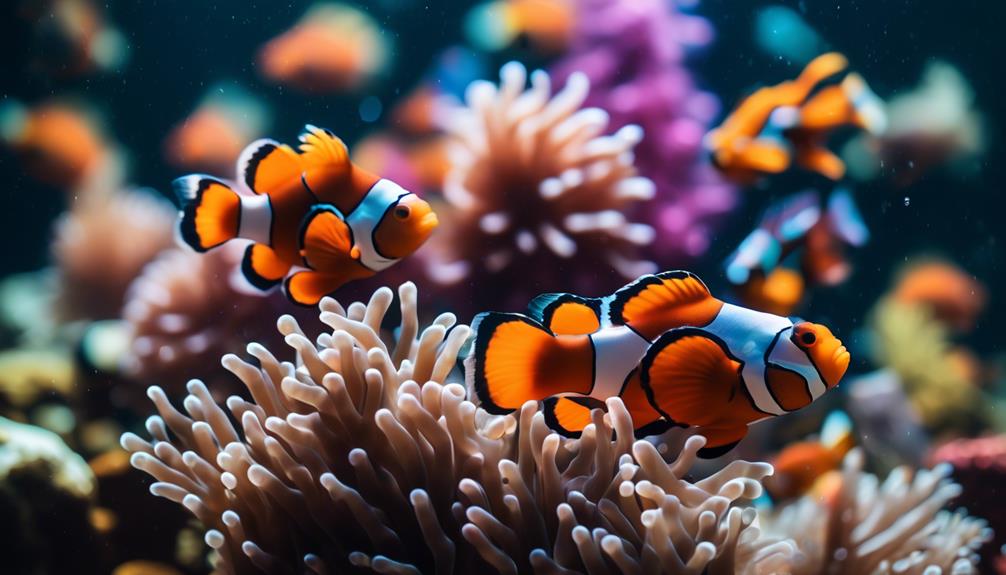
When considering tank mates for your clownfish in a saltwater aquarium, it’s important to understand the description and popularity of these fascinating fish. Here are three key points to keep in mind:
- Most popular species:
- Clownfish are the most popular species among saltwater aquarium enthusiasts.
- Their beautiful colorations and waddle-like swimming motions make them a beloved choice for many hobbyists.
- Significant sales:
- Clownfish account for over 40% of total sales in the marine aquarium fish trade.
- Their popularity is evident in the high demand for these captivating creatures.
- Symbiotic relationships:
- Clownfish develop symbiotic relationships with sea anemones.
- They’re immune to the anemones’ poisonous tentacles, and this unique bond adds to their allure.
Understanding these aspects of clownfish description and popularity will help you make informed decisions when setting up your saltwater aquarium.
Maintenance and Care
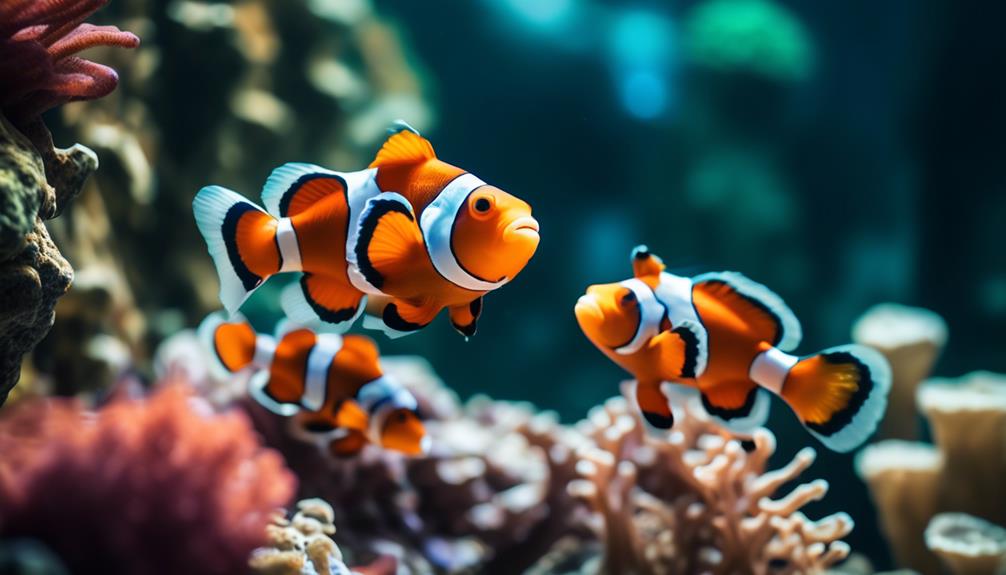
Are you looking for tips on how to properly care for and maintain your clownfish in a saltwater aquarium? Clownfish are relatively hardy species of fish that can live up to 6 years in captivity with proper care. It is important to provide them with a medium-sized aquarium, preferably around 30 gallons, with open swimming spaces and hiding places. Tank-raised clownfish adapt faster to aquarium life, so it is recommended to choose them over wild-caught ones. Additionally, it is best to research specific requirements for raising anemones as hosts, as clownfish develop symbiotic relationships with them. Here are some general guidelines for maintaining and caring for your clownfish:
| Maintenance and Care |
|---|
| – Provide a suitable tank size |
| – Create open swimming spaces and hiding places |
| – Choose tank-raised clownfish |
| – Research anemone requirements |
| – Monitor water parameters regularly |
| – Perform regular water changes |
| – Feed them a varied diet |
| – Observe their behavior and health |
| – Seek professional help when needed |
Feeding and Breeding
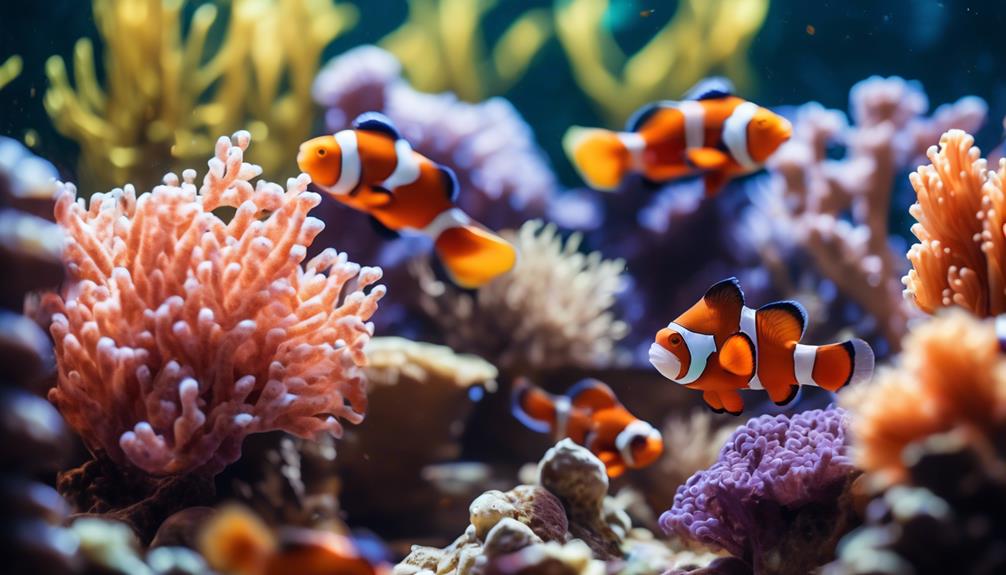
To ensure the health and breeding success of your clownfish, it’s essential to understand their feeding habits and reproductive behavior. Here are three important things to know:
- Diet: Clownfish are omnivores and will accept most types of food, including flakes. However, it’s important to supplement their diet with live and vegetable-based foods to ensure optimal nutrition.
- Breeding Behavior: Clownfish are all born male, but the dominant male will turn into a female when breeding. They lay their eggs on flat surfaces, such as rocks or the sides of the aquarium, and guard them zealously until they hatch.
- Breeding Difficulty: Clownfish are considered one of the easier species to breed in the aquarium. With the right conditions and proper care, they can successfully reproduce. However, it’s important to provide them with suitable breeding surfaces and closely monitor their behavior during the breeding process.
Small Size and Saltwater Habitat
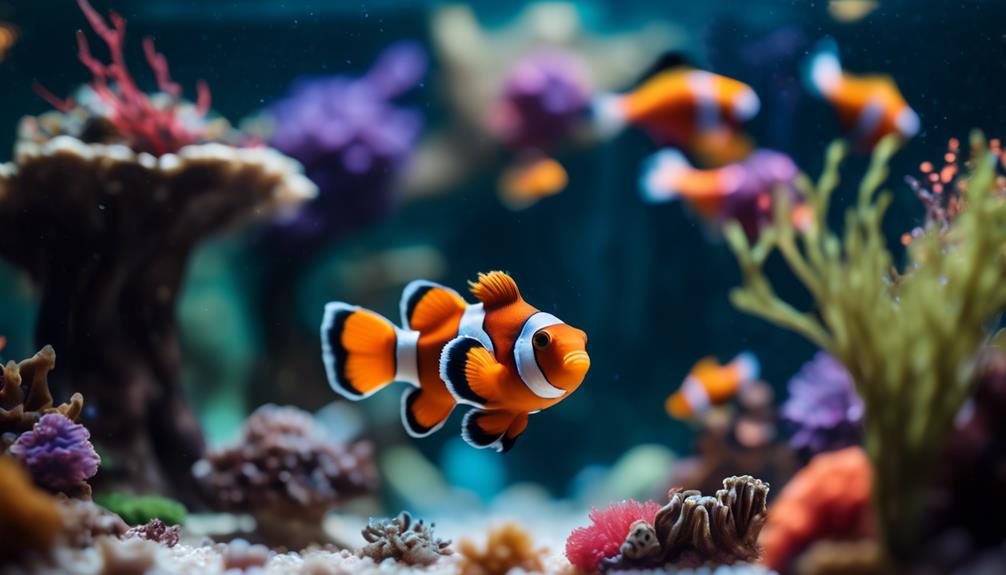
Clownfish, known for their small size and preference for saltwater habitats, are a popular choice among aquarium enthusiasts. These vibrant fish thrive in the saltwater environment and require a medium-sized aquarium of at least 30 gallons.
They’re community aggressive, so it’s important to choose suitable tank mates like damsels, dartfish, gobies, hawkfish, puffers, and tangs. Clownfish swim in the middle region of the tank and prefer open spaces with hiding places.
They’re relatively hardy and can live up to 6 years in captivity with proper care. Feeding them is relatively easy as they’re omnivores and accept most types of food, including flakes.
Breeding clownfish is also possible in the aquarium, as they lay eggs on flat surfaces and guard them zealously.
Unique Community Aggressive Temperament
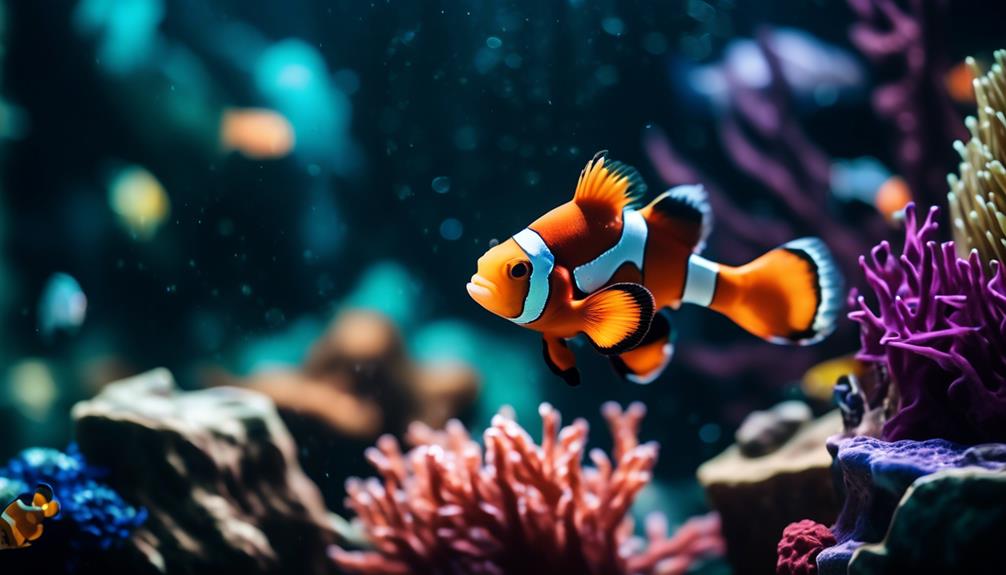
With their unique community aggressive temperament, clownfish bring a lively and dynamic energy to any saltwater aquarium. Here are three reasons why their temperament makes them stand out among other fish:
- Territorial behavior: Clownfish are known to establish their territory within the aquarium. They fiercely defend their chosen area, especially if it contains an anemone, which they form a symbiotic relationship with. This territorial behavior adds an interesting dynamic to the aquarium, as they interact with other fish and protect their space.
- Chasing and aggression: Clownfish can exhibit aggressive behavior towards other fish that come too close to their territory. They’re known to chase away intruders, creating a visually captivating display of their dominance. This behavior not only adds excitement to the tank but also helps maintain balance within the fish community.
- Hierarchy and social structure: Clownfish have a hierarchical social structure, with a dominant male and a submissive female. This unique dynamic adds complexity to their behavior as they establish their roles and interact with other clownfish and tank mates. Observing their interactions can provide a fascinating glimpse into the intricate social lives of these captivating creatures.
Ideal Tank Size and Swimming Behavior
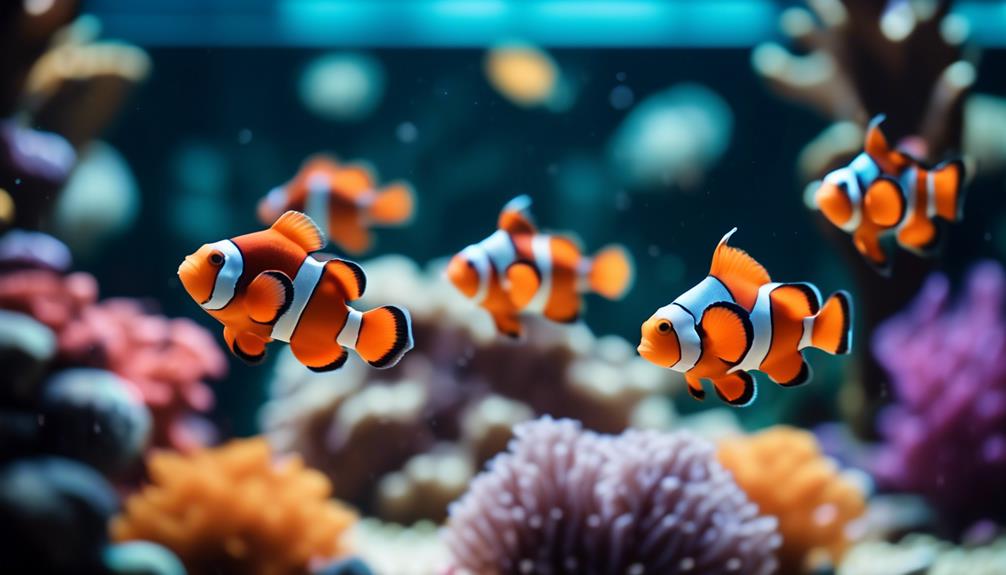
The ideal tank size for clownfish and their swimming behavior are important factors to consider when setting up a saltwater aquarium.
Clownfish are small-sized fish that require a medium-sized aquarium of at least 30 gallons. They’re known to swim in the middle region of the tank, creating a lively and active display.
Providing them with open swimming spaces and hiding places will ensure their well-being. When choosing tank mates, consider species like damsels, dartfish, gobies, hawkfish, puffers, and tangs that are compatible with clownfish.
It’s also essential to research specific requirements for raising anemones as hosts, as clownfish form symbiotic relationships with them.
Colorful Varieties and Waddle-like Swimming Motion
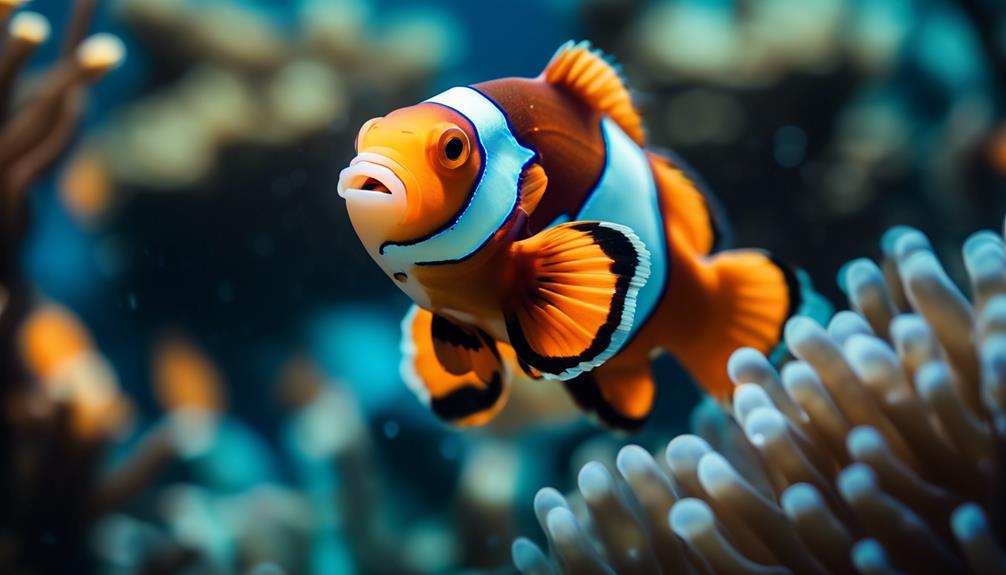
As you explore the fascinating world of clownfish in saltwater aquariums, you’ll be captivated by their vibrant colors and unique waddle-like swimming motion.
These colorful varieties are a sight to behold, with their striking combinations of orange, white, yellow, and black. From the popular Ocellaris clownfish with its bold orange body and white stripes, to the exquisite Maroon clownfish with its deep red hue, these fish bring a burst of color to any aquarium.
But it’s not just their appearance that’s captivating. The waddle-like swimming motion of clownfish adds an extra element of charm to their personality. As they gracefully move through the water, their bodies sway from side to side, giving them a distinctive and endearing waddle.
It’s no wonder why clownfish are such beloved stars of saltwater aquariums.
Symbiotic Relationships With Sea Anemones
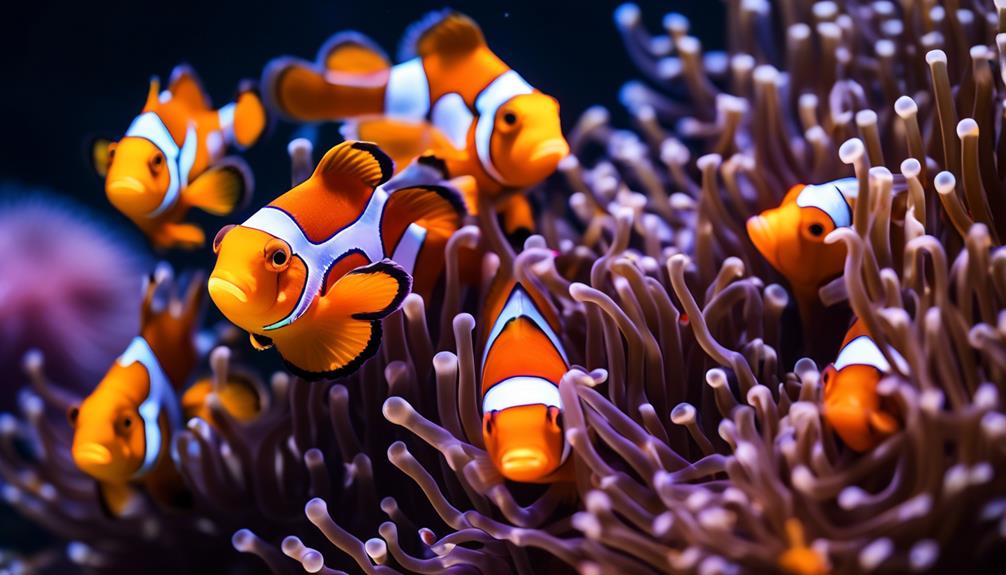
Have you ever wondered how clownfish develop symbiotic relationships with sea anemones? It’s quite fascinating!
Clownfish and sea anemones have a unique partnership where they rely on each other for survival. The clownfish live among the tentacles of the sea anemone, which offers protection from predators. While other fish would be stung by the anemone’s poisonous tentacles, the clownfish are immune to their venom.
In return, the clownfish provide food for the anemone by bringing in small scraps and leftover food. They also help to circulate water around the anemone, ensuring that it receives the nutrients it needs.
This mutually beneficial relationship is an incredible example of nature’s intricate web of connections.
Immunity to Anemones’ Poisonous Tentacles
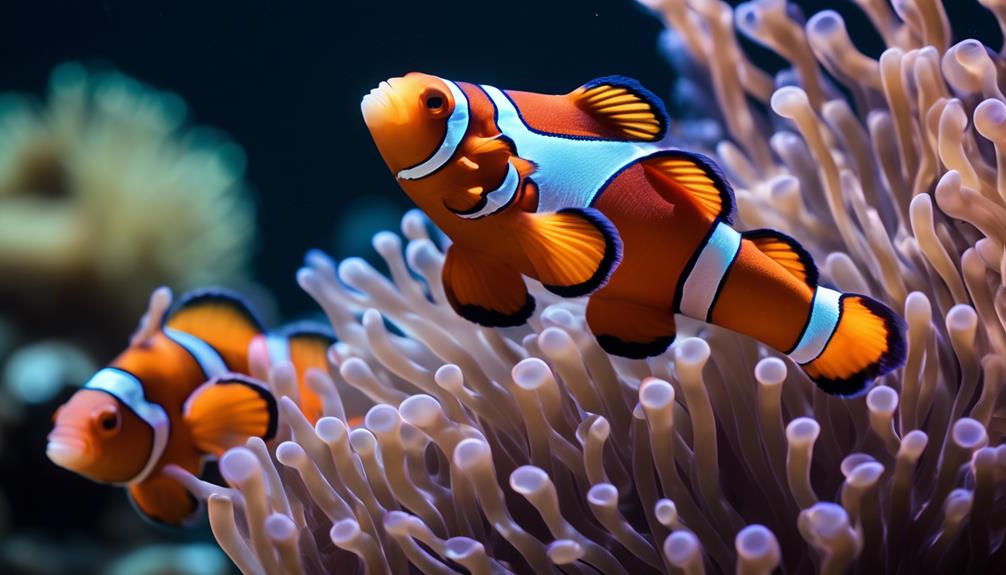
Clownfish demonstrate a remarkable immunity to the poisonous tentacles of sea anemones. This unique ability allows them to live harmoniously within the anemone’s stinging embrace. How do they do it? Let’s explore the reasons behind their immunity:
- Mucus Protection: Clownfish are covered in a thick layer of mucus that acts as a shield against the anemone’s toxins. This mucus not only protects them from the stinging cells but also helps maintain their symbiotic relationship.
- Gradual Adaptation: Clownfish aren’t born immune to the anemone’s toxins. Instead, they develop resistance over time by gradually exposing themselves to the anemone’s venom. This process allows them to build up a tolerance and survive within the anemone’s tentacles.
- Unique Protein Production: Studies have shown that clownfish have a unique protein production system that helps neutralize the venom. This special adaptation allows them to thrive in the presence of anemones without suffering from their poisonous effects.
Hardy Species With Longevity in Captivity
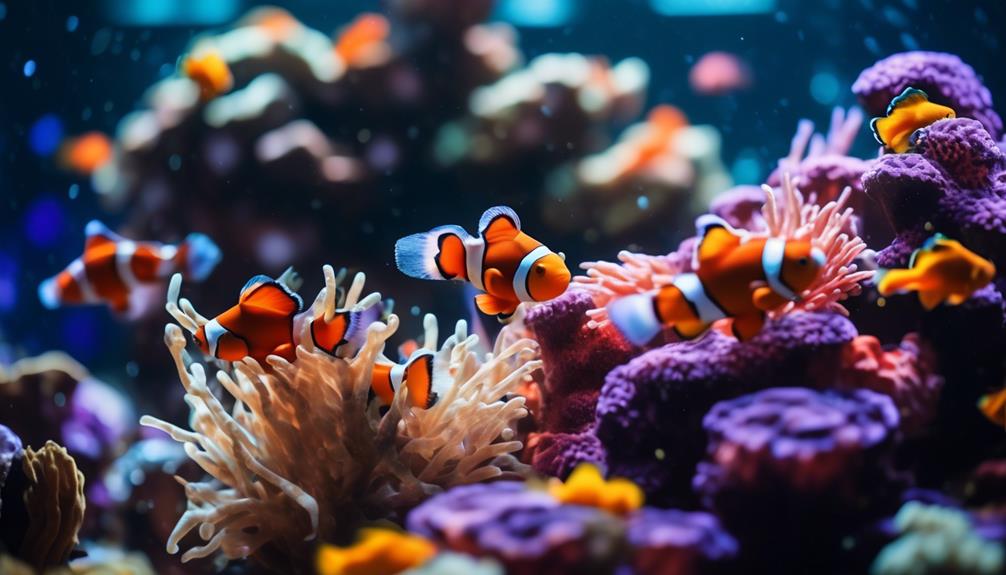
Clownfish, renowned for their immunity to the poisonous tentacles of sea anemones, aren’t only fascinating in their symbiotic relationship, but they’re also a hardy species with impressive longevity in captivity. These small, saltwater fish are a popular choice among aquarium enthusiasts for their vibrant colors and waddle-like swimming motions. With proper care, clownfish can live up to six years in captivity. They’re relatively hardy and adapt quickly to aquarium life, especially if they’re tank-raised.
It’s important to provide them with an adequately sized tank, open swimming spaces, and hiding places. Clownfish are omnivores and accept a variety of foods, including flakes, but their diet should be supplemented with live and vegetable-based options.
Breeding clownfish can also be a rewarding experience, as they’re known to guard their eggs zealously and are considered one of the easier species to breed in captivity.
Adaptation of Tank-Raised Clownfish
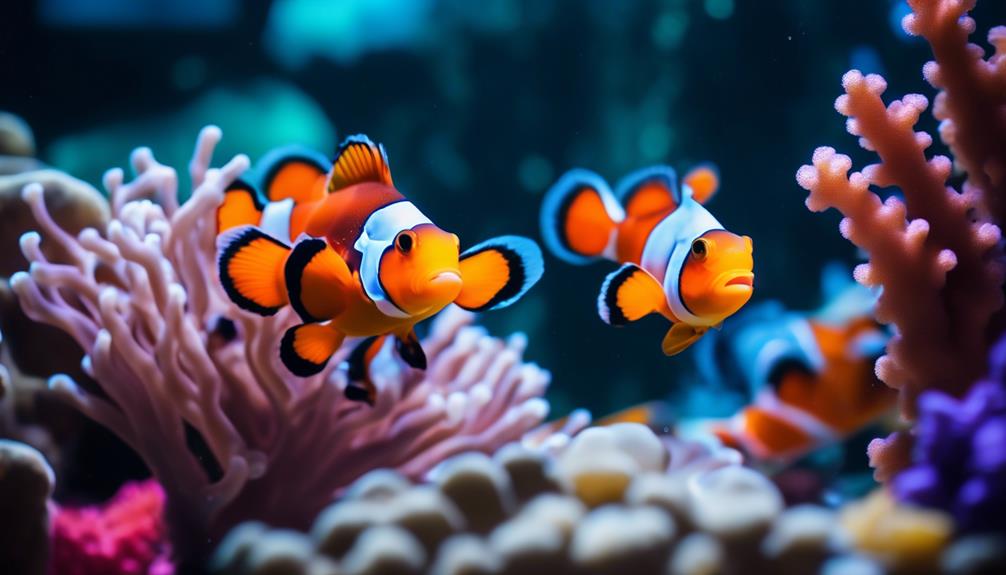
Tank-raised clownfish easily adapt to aquarium life and exhibit remarkable resilience. They’re specifically bred to thrive in captivity, which makes them more acclimated to the conditions of an aquarium compared to wild-caught clownfish.
Here are three reasons why tank-raised clownfish are highly adaptable:
- Familiarity with artificial environments: Tank-raised clownfish grow up in controlled settings, where they’re exposed to artificial lighting, filtration systems, and stable water parameters. This familiarity allows them to adjust quickly to an aquarium environment.
- Prepared for captive feeding: Tank-raised clownfish are trained to accept a variety of foods, including flakes and frozen options. They’re accustomed to eating in captivity, making it easier for aquarium owners to provide a balanced diet.
- Reduced stress levels: Unlike wild-caught clownfish, tank-raised specimens don’t experience the stress of capture and transportation. This reduces the chances of disease and helps them settle into their new home more rapidly.
Researching Anemone Requirements for Hosts
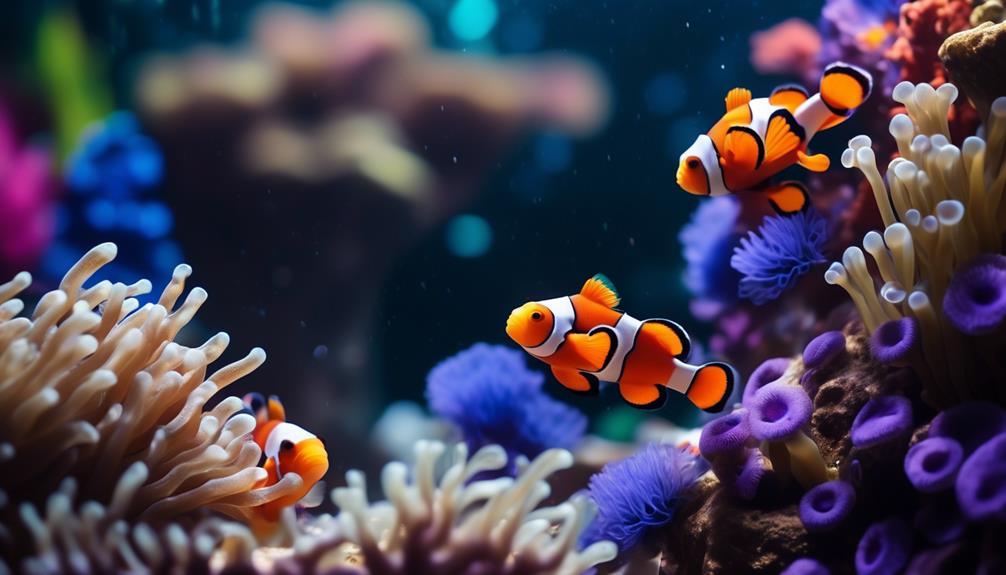
What are the specific requirements for raising anemones as hosts for clownfish in saltwater aquariums?
When it comes to providing the right environment for anemones, there are a few key factors to consider.
First and foremost, you need to make sure your tank has stable water conditions, including temperature, salinity, and pH levels.
Anemones also require a well-established and mature tank, as they’re sensitive to changes in water quality.
Lighting is another important consideration, as anemones need moderate to high levels of light to thrive.
Additionally, providing proper water flow and filtration is crucial for their health.
Lastly, it’s essential to choose anemone species that are suitable for your tank size and compatible with clownfish.
Frequently Asked Questions
How Do Clownfish Develop Symbiotic Relationships With Sea Anemones?
Clownfish develop symbiotic relationships with sea anemones by gradually acclimating to their tentacles’ stinging cells. This process involves building immunity, allowing clownfish to live within the anemone’s protective tentacles without being harmed.
What Is the Lifespan of a Clownfish in Captivity?
In captivity, a clownfish can live up to 6 years with proper care. Tank-raised clownfish adapt better to aquarium life, so make sure to provide open swimming spaces and hiding places for them.
What Are the Specific Requirements for Raising Anemones as Hosts for Clownfish?
To raise anemones as hosts for your clownfish, ensure you have proper lighting, water flow, and water quality. Choose anemones that are suitable for your tank size and provide them with a stable environment.
How Do Clownfish Breed and Care for Their Eggs?
To breed and care for their eggs, clownfish lay them on flat surfaces and guard them fiercely. The dominant males turn into females for breeding. With proper care, clownfish can live up to 6 years in captivity.
What Types of Food Should Be Included in a Clownfish’s Diet for Optimal Health and Nutrition?
For optimal health and nutrition, include a variety of food in your clownfish’s diet. They are omnivores and accept most types of food, but supplement their diet with live and vegetable-based foods.
Are Anthias Fish Compatible with Clownfish in a Saltwater Aquarium?
Yes, colorful anthias fish in saltwater aquariums are usually compatible with clownfish. Anthias are peaceful and won’t bother clownfish. It’s essential to have a large enough tank with plenty of hiding spots to avoid territorial disputes. Monitoring their behavior will ensure a harmonious cohabitation.
Conclusion
In conclusion, if you’re looking for vibrant and captivating creatures to add to your saltwater aquarium, clownfish are the perfect choice. With their beautiful colorations, waddle-like swimming motions, and ability to form symbiotic relationships with sea anemones, they’re truly mesmerizing.
Clownfish are relatively hardy and make great tank mates for other species. By providing proper maintenance, care, and a suitable diet, you can ensure their longevity and happiness in your aquarium.
So, dive into the enchanting world of clownfish and enjoy their presence in your tank.




